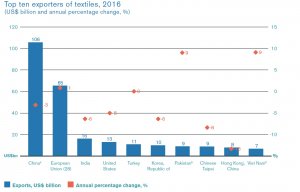
World textile and apparel exports fall in 2016
Textile and clothing exports from member countries of the Association of Southeast Asian Nations (Asean) declined sharply in 2012, according to a new report from the global business information company Textiles Intelligence. The main causes were declines in exports to the USA and the EU, although the overall trends masked significant variations in export performances between Asean member countries.

25th July 2013
Knitting Industry
|
UK
Textile and clothing exports from member countries of the Association of Southeast Asian Nations (Asean) declined sharply in 2012, according to a new report from the global business information company Textiles Intelligence - World Textile and Apparel Trade and Production Trends: South-East Asia
The main causes were declines in exports to the USA and the EU, although the overall trends masked significant variations in export performances between Asean member countries.
The worst performing country was the Philippines, where clothing exports declined by 17.0%. Malaysian textile and clothing exports were down by 12.4%, Thai textile and clothing exports by 12.2% and Indonesian textile and clothing exports by 6.3%.
There were some bright spots, however, with Cambodian textile and clothing exports up by 8.7% and Vietnamese textile and clothing exports up by a similar 8.5%.
The declines in textile and clothing exports from Malaysia and Thailand reflected sharp declines in exports to the EU and the USA. However, both countries are less dependent on these two markets than are most of their Asean counterparts, and their exports to other markets were, for the most part, buoyant.
Indonesian textile and clothing exports to the USA and the EU also declined but sales were buoyed by domestic demand, which continued to surge.
In the Philippines, the decline in clothing exports was due to lower demand in the USA and most other foreign markets. Sales in the EU market, by contrast, increased.
Sales of Cambodian textiles and clothing in the EU market surged by 32.4% following the EU’s decision to relax the rules of origin of its Generalised System of Preferences (GSP) scheme. Sales in the US market, however, fell by 2.0%.
Vietnamese textile and clothing exports, meanwhile, seemed to be unaffected as the industry posted growth in sales in the EU, the USA and Japan, as well as several other countries, including China, Russia and South Korea.
“World Textile and Apparel Trade and Production Trends: South-East Asia” was published by the global business information company Textiles Intelligence and can be purchased by following the link below:
World Textile and Apparel Trade and Production Trends: South-East Asia
Other recently published reports from Textiles Intelligence include:
Survey of the European Fabric Fairs for Spring/Summer 2014
Global Trends in Fibre Prices, Production and Consumption
Product Developments and Innovations in the Home Textiles Market

Business intelligence for the fibre, textiles and apparel industries: technologies, innovations, markets, investments, trade policy, sourcing, strategy...
Find out more